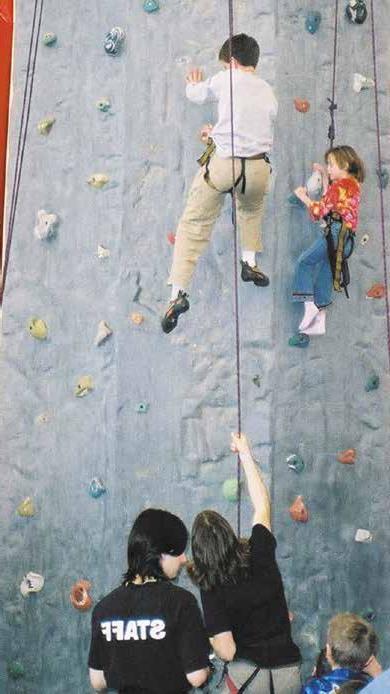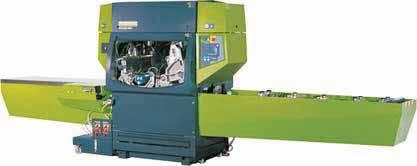
14 minute read
A map of the local ski hills


Advertisement





















Illustration by Lisa Kinloch and Francois Daigle.
Calabogie Peaks Resort Inn

The staff here at Ottawa Outdoors fell in love with the Calabogie Peaks Resort and their new Inn. This is going to be a hotspot for those seeking a romantic weekend getaway, to a fun familiy outing of snow sports and play (think school’s out and winter holidays).
Here’s a run down of all they have and what we can’t wait to get to:
The “Dickson Manor”. This 25 room fine Country Inn located at the base of Dickson Mountain has major winter rustic charm. Amenities which include a(n): - indoor swimming pool, - outdoor hot tub, - fitness room, - arcade room, - and a mini movie theatre
There is also a plethora of outdoor recreational activities to experience as well, including: - snowshoeing, - x-country skiing, - snowboarding, - and downhill skiing on Ontario’s highest public ski hill.
And the piece de resistance— a new spa, Les Saisons, which offer various packages including: massage, facials, herbal and mud wraps, Soladerm self tanning, manicure, pedicure and waxing. Gotta love this after a day on the slopes!
Throughout the winter season a weekday getaway can just be what’s needed. See you there!
www.Calabogie.com
Bounding along in snowless bliss [you know, when it melts again]
By Eric Finstad BHSC (P.T.), M.SC. and Nicola Cameron
Unlimited—the recently released cross-country video by Ottawabased company XC Zone—is like porn for the cross-country skiing enthusiast.
Boot-level shots of hairpin turns, bulging quads and powerful torsos make parkway peaks seem like downhills. Ahh, the sound of speed on snow. Then there’s the cold shower of watching the snow melt and the dry-land training section of the film begins.

The glamour of glide is replaced by a woman making her way up a steep, rocky hill in a slow and peculiar fashion, accompanied by the annoying “tick, tick, tick” of her poles scraping on gravel. The scene puzzled my movie-viewing partner, but we were watching an essential training tool for any crosscountry skier who wants to make their season as exciting as it is “unlimited.”
Ski bounding—the technique of mimicking classic skiing while running with poles—is one of the best ways to improve fitness and technique during those sad non-snow seasons. It combines specific training for your skiing muscles, provides an excellent opportunity to focus on your technique, and it’s a grueling cardiovascular workout.
Good ski bounders can mimic the technique so well that they actually look as if they are skiing, and some coaches maintain that the motion is a more ski-specific motion than roller skiing.
With this in mind, there are some key technique hints to Beginning of pole plant: arm slightly bent; pole at heel. consider when venturing up a hill for your first attempt.
Ski bounding tips
Equipment: Locate some poles that aren’t terribly valuable (they’ll get scratched by rocks) and that force your arms into a 90-degree angle when you are standing with your hands in the straps and the poles in front of you. Poles should come up to your armpits while standing. Too-long poles make technique much more difficult.
Location: Find a hill. While this sounds obvious, bounding is only effective if used on a fairly steep hill. Penguin is an exciting choice. Think of the Keskinada.
What to do with your pole
Ski bounding is the technique of mimicking skiing while running. The most obvious difference between the two is the addition of some poles. • Swing your poles as you would for skiing (opposite arm to opposite leg—for some reason, this is less intuitive while not on skis.)

Plant your pole at around your heel withyourhand in front of where the pole tip is planted and your armonly slightly bent. Ensure that your arm does not bend much further during your swing—this common mistake is called “collapsing your elbows.” Instead, push down and a little behind you so that your arm maintains a constant angle while swinging back. Your hand should follow parallel to the slope of the hill as your arm extends behind you.
What to do with your feet
Foot placement can sometimes be the critical element in discovering the difference between jogging with poles and the tricky art of bounding. • Reach forward with your leading foot—don’t simply let it swing forward as you would in running. This will also cause your hips to rotate around the central axis—an important technique in order to achieve proper weight shift and forward drive. • Ensure that your back foot does not kick up towards your bum the way it does while running. This is very important! Pretend you have skis on your feet—that way, your heels have to stay close to the ground.
James Raffan “Canoesongs”
CD Release Party! Friday 8:30-11pm > Admission $6.00

Olympic Sized Pool for Test Paddling and Events



the
25 foot Climbing Wall Seminars
Show times: Fri 4-8pm > Sat. 9am-7pm > Sun 9am-4pm Weekend Pass*: $10.00 Adults, $8.00 Students and Seniors Children under 12 free when accompanied by an adult trailheadshow
*50% ticket refund on first purchase over $25.00! March 5 > 6 > 7, 2004 THE CARLETON FIELD HOUSE
Where Your Adventures Begin
WWW.TRAILHEAD.CA/SHOW TICKETS AVAILABLE AT TRAILHEAD 1960 SCOTT ST. OTTAWA (613)722.4229
Free Parking, Fashions Show, Adventure Race, Manufacturers, Outfitters, Inventors, Guides, Clubs, Conservation Groups, Canoe Kayak Climbing Skiing Rafting Schools, World Class Athletes, Expert Lecturers, Government Information Specialists, Outdoor Chefs, Authors, Artists and lots more...
THE BEST OUTDOOR EQUIPMENT BARGAINS IN CANADA
appropriate to the dance floor than to the Gatineau trails. Preload the push-off leg: pretend there’s a shock absorber between your knee and the front ofyour ski as you push down and spring off during the weight-bearing portion of your stride.
What to do with your torso

Good ski bounders look as if they are hungry for the hill; they lean their upper body into the hill, driving all their power forward. A bouncing motion indicates not enough forward drive.
What to do with your head
To maintain your forward drive up the hill, focus a few paces ahead of your skis. If you are not the fastest bounder in the group, this will also allow you to observe your training partner’s hilarious technique at close quarters, including the abovementioned over-rotation of the hips. As with all workouts, having fun while building strength should be a priority.
Shift your weight decisively from leg to leg. Your weight shift is always the most important factor in any ski technique. • Instead of having your centre of balance running down the centre of your body as it does in running, your weight should shift completely from foot to foot. • To ensure solid balance (and effective glide once on snow), ensure that your head is over your weight-bearing hip that is over your weight-bearing foot. A common mistake is to extend the hips over the foot without moving the head, resulting in a hip swing more
Complete weight shift: head in line with weight-bearing hip and foot.
What to do with your legs
The first bounding workout of the year is always a physical and mental challenge. From the burning sensation that emanates from your under-used posterior to the even less comfortable sensation that you look like a dork, it is usually an outing that involves lots of leaning on poles and gasping.
The triumph of regaining one’s technique and the inevitable satisfaction of superior performance once on snow, however, far outweigh the discomforts of learning to “pretend” that you are skiing when you clearly aren’t. The “tick, tick, tick” of poles on gravel can be the sweet prelude to a chorus of “how did you get so fast?” come winter. —Eric Finstad is a registered physiotherapist and former member of the National Cross-Country Ski Team. Nicola Cameron is a member of the Carleton University Ski Team.

P ro fe s s io n a l P ro fe s s io n a l W h e n i t 's t h e b e s t y o u n e e d , W h e n i t 's t h e b e s t y o u n e e d , it 's t h e b e s t y o u g e t wit hit 's t h e b e s t y o u g e t wit h W IN T E R S T E IG E R t u n in g t e c h n o lo g y.W IN T E R S T E IG E R t u n in g t e c h n o lo g y. G e t y o u rG e t y o u r ri d eri d e b a c kb a c k u pu p t ot o s n u ff wi t hs n u ff wi t h o u ro u r fu l l yfu l l y


c o m p u t e ri z e dc o m p u t e ri z e d
s t a t es t a t e o fo f t h et h e a rta rt l o g i cl o g i c t u n i n gt u n i n g


ro b o t .ro b o t .

Mont Cascades Resort. . . The best in the Outaouais 819-827-0301 region! www.MontCascades.ca or Toll Free 1-888-282-2722 Inquire about our Ski school programs: Night season pass for as Ski by the hour, exclusively at • • • kids starting at 3 years of age 50% off weeknight program for adults, register before January 5, 2004 Weekend program for adults and kids low as $69 ** ** some conditions apply Mont Cascades Resort Mont Cascades Resort, closer than you might think!


By Ken Parker T he state of human fitness is at an all-time low.
At the other end of the spectrum, however, ultra-athletes could be overreacting to their detriment. More and more of us are registering in ultra-events like adventure races and ironman triathlons. We live in a world of fitness extremes, where couch potatoes and exercise fanatics gaze upon each other across a very wide gulf.
We all know that avoiding exercise is a bad thing. But, can exercise become too much of a good thing?
The benefits of regular moderate exercise are legendary—it reduces cardiovascular risk factors, slows the aging process, improves functional capacity, and it bolsters mental health and well-being.
Taken to excess, however, exercise has a down side. A study of Harvard alumni by Stanford University’s Ralph Paffenbarger found that death rates were lower for men who were involved in regular physical activity. The death rate declined with the increase in calories burned during physical activity—but only up to a point. Death rates began to go up slightly among men who expended more than 3,000 extra calories per week.
“Excessive exercise can backfire on you,” says Dr. Ken Cooper, a physician who heads the Cooper Institute for Aerobic Research in Dallas, Texas, and the father of “aerobics.” Cooper argues that there appears to be a point of diminishing returns where your immunity is adversely affected and you break down your resistance to infection and disease. “(How much is too much) varies according to the fitness level of the individual,” he explains.
There is a growing number of “exercise addicts” who exercise beyond reason and who put their need for exercise ahead of a balanced lifestyle.
In a Health and Body column, New York Times writer Andre Taber contends, “American athletes tend to be an obsessed bunch, but the trend toward endurance extremes has sounded alarms in the medical community. In the short term, common consequences of prolonged, strenuous exercise include tendonitis, stress fractures and chronic fatigue syndrome. But research is beginning to show that by racing ever farther and longer, athletes may also be putting themselves at risk for a host of chronic diseases, even cancer.”
Liz Applegate, a nutrition professor at UC Davis, is not surprised at the news that extreme athletes may be compromising their health.
“People can do it, but the body wasn’t meant to do it,” Applegate says, noting the renowned feats of athletes like triathlete Mark Allen, who captured the Hawaii Ironman six times. “There are a bazillion stories of athletes who have developed chronic fatigue syndrome,” says Applegate, singling out overtraining as the most common ailment among the ultra-athlete set.
Studies have shown that high intensity resistance exercise increases free radical (molecular instability) production. Endurance exercise can increase oxygen utilization from 10 to 20 times over the resting state. A free radical can destroy a protein, an enzyme, or even a complete cell. To make matters worse, free radicals can multiply through a chain reaction mechanism resulting in the release of thousands of these cellular oxidants. When this happens, cells can become so badly damaged that DNA codes can be altered and immunity can be compromised.
Natural antioxidants like vitamins C and E (which are prevalent in fruits and vegetables) combat oxidative damage, and are abundant in most healthy eating habits. Under moderate strain, the body’s biology can easily adapt, activating its stores of antioxidants and extinguishing “oxygen fires,” as Applegate calls them. She believes that when athletes repeatedly push themselves through prolonged exhaustive training sessions, the body can no longer keep up.
“There are red flags all over that the immune system is under stress and not performing well,” says Dr. David Nieman, a former marathoner who studies extreme exercise as Director of the Human Performance Laboratory at Appalachian State University. “Some immune cell functioning is down for hours. Some is suppressed for days.”
While it is not currently possible to draw a link between extreme athletics and cancer, molecular tests have proven the effects of oxidative damage.
Mercury professional cycling team physician Prentice Steffen doesn’t dismiss the theoretical possibility that cancers may be related to over-exercising. He cites Lance Armstrong as an example—the American cyclist who developed testicular cancer in 1996 and has since recovered and returned to competition.
Growing evidence also suggests that an ultra-distance addict could be accelerating the aging process. Steffen contends that ultra-athletes need to become proponents of moderation: “Anything in the extreme is not good,” he says. “The body and its joints only have a certain lifetime. They’re using up too much too soon.”
— Ken Parker is a long-time runner, coach and race organizer.









